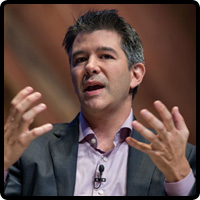The current evolution of transportation is being driven by the convergence of a series of industry-changing forces and megatrends, and accelerated by technology companies. The growing need for flexible and adaptive mobility solutions has set the stage to further optimize how we use the existing infrastructure in our cities including roads, public transportation, and parking–many of these solutions are being deployed outside the realm of the public sector. This month we have partnered with Shared Mobility Strategies, LLC to select the Top 10 Private Sector Disruptors in Transportation. These innovators are leveraging mobile technologies to improve productivity, profitability and operations. They are building the foundation for a new generation of technologies that will enable enterprises to connect devices across a centralized cloud network, and capture and share mission-critical data.
In selecting these disruptors we considered individuals who were responsible for new and groundbreaking efforts—many featured in this article have launched a “first-of-its-kind” product or even established an entirely new industry. We also sought to highlight areas of innovation that have attracted widespread use by consumers and caused incumbent industries to adapt or alter their performance to keep up. These trail blazers have lead the development of new regulatory frameworks or forced policy reform to better serve the mobility and transportation needs of the public, help cities move more efficiently, and reduce barriers to innovation. Ultimately, the individuals below have introduced new business models to tackle some of the country’s most pressing, widespread, and safety critical transportation challenges.

Kaye Ceille, Zipcar
Kaye Ceille was named Zipcar president in January 2014 following 20 years at its parent company, Avis Budget Group. Launched in 2000, Zipcar has been all about shared mobility since well before shared mobility was cool. By providing vehicles to rent for as little as half an hour, the company’s model has provided a critical option for city dwellers that want to go car-free, but may need the occasional use of a car. However, Zipcar isn’t done innovating—in 2015 they purchased fleet management service Local Motion to bring many of the processes and efficiencies from the ‘shared economy’ into the enterprise space. The Local Motion platform allows operators of large fleets to share vehicles effortlessly, increase utilization, and streamline operations.
(Photo courtesy: HCI.org)

Matt Cole, Cubic Transportation Systems
Matt Cole, president of Cubic Transportation Systems (Cubic), is working to reimagine the way cities move. He is the visionary behind NextCity, which delivers a seamless, multi-modal framework for city management and integrated traveler payment and information to focus on integrating accounts, customer experiences, operations and analytics. This means the traveling public will be empowered with actionable intelligence and information to make smarter, more informed travel decisions. Cubic’s partnerships with academia, customer and industry innovators such as Microsoft, and Cubic’s enterprise solution partner for transportation management are driving solutions for improving cities affected by urban growth and transportation congestion.
(Ed. Note: We recently interviewed Matt about his newest project)

Aicha Evans, Intel
The cars of the future are here today, and they are processing massive amounts of data and information. Intel is seeking to create a new class of smart and connected transportation solutions and leading the charge is Aicha Evans, Corporate Vice President and GM of the Intel Communication and Devices Group. From advanced driver assistance systems (ADAS) to breakthrough technologies that will contribute to fully autonomous driving–Intel IoT ecosystem is collaborating with firms like Ericsson, KT, LG Electronics, Nokia, Telecom, and Verizon to help lay the foundation for 5G. Together, the Intel IoT ecosystem is developing and testing secure, high-bandwidth 5G connectivity in autonomous vehicles and preparing for the expected rollout of 5G in 2020.
(Photo courtesy: Twitter)

Jim Hackett, Ford Smart Mobility
The former CEO of Steelcase, an office furniture supplier, has taken the helm of the newly formed Ford Motor Company subsidiary tasked with developing and deploying innovative new mobility services under the Ford umbrella. In addition to remaining focused on its core business in the car industry, Ford Smart Mobility is at the heart of the company’s plan to also establish itself as a leader in connectivity, mobility, autonomous vehicles, customer experience, and data and analytics. Set up to compete like a startup company, Ford Smart Mobility LLC will design and build mobility services on its own, and collaborate with start-ups and tech companies.
(Photo courtesy: Forbes)

Travis Kalanick, Uber Technologies
In just six years Uber’s CEO, Travis Kalanick has grown the ridesharing app from a niche black car on-demand platform in limited geographies, to a $62 billion global mobility and logistics company. Uber’s regulatory battles have resulted in the emergence of new Transportation Networking Company (TNC) regulatory frameworks in a majority of US states as well as in a growing number of international cities and countries. Kalanick has now set his sights on building and deploying fully self-driving vehicles in an effort to disrupt then reinvent public transportation.
(Photo courtesy: Smartcompany.com)
(Ed. Note: We got to talk to Uber’s first ever policy lead. Read the interview here)

Elon Musk, Tesla
Few individuals have the ability to imagine the seemingly impossible and then achieve it the way Tesla’s founder and CEO Elon Musk has. From revolutionizing the way payments are made with PayPal, to landing a private space shuttle on a barge, Musk has stretched the limits of imagination and innovation. Nowhere is this more evident than how Musk has now sets his sights on bringing affordable, high quality, environmentally sustainable automobiles to the masses with the Model 3.
(Photo courtesy: Entrepreneurlife.com)

Nat Parker, moovel
Moovel CEO Nat Parker is in hot “pursuit of the most seamless experience for both transportation providers and consumers to define the future of mobility.” Since 2010, GlobeSherpa and RideScout built mobile solutions to help people navigate their city with real-time information and mobile payments. After successful acquisitions, the companies merged in 2016 to become moovel NA, a subsidiary of Daimler AG. From moovel transit for public transportation ticketing, to Ride Tap for discovery of new rides, moovel apps offer all available mobility options for planning journeys.
(Photo courtesy: geekwire.com)

Chris Urmson, Google Self-Driving Car
Chris Urmson was a member of the Carnegie Mellon University team that won the 2004 DARPA Grand Challenge to build an autonomous vehicle. Urmson has been the face of the Google X Self-Driving Car Project for years now, and while the company has brought on former Hyundai executive John Krafcik to run the business of commercializing their technology, Urmson has remained the driving force behind Google’s efforts appearing before key regulators to chart the legislative pathway for this technology.
(Photo courtesy: autonews.com)


John Zimmer and Logan Green, Lyft
Few people realize that Logan Green and John Zimmer were disrupting cities and the taxi industry long before Uber, when in 2007 they founded Zimride, a ride-sharing service started on the campus of Cornell University. Since launching Lyft in June 2012, the company has positioned itself as a more community-focused Transportation Networking Company (TNC), than its main competitor. It has also succeeded in attracting a large number of women drivers to the platform. Lyft has recently formed alliances with China’s Didi Kuaidi, India’s Ola Cab, and Singapore’s GrabTaxi. Moreover, they have entered into a $500 million partnership with General Motors that positions the company to compete in the emerging autonomous vehicle space.
(Photo courtesy: Lyft)













